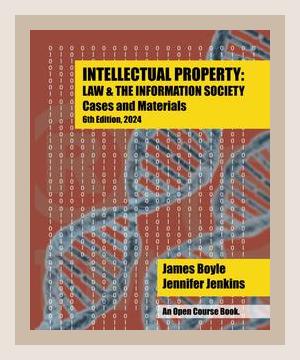Business Law and EthicsIntellectual Property
Introduction
The book “Intellectual Property: Law & the Information Society – Cases & Materials” by James Boyle and Jennifer Jenkins serves as a comprehensive guide to understanding the nuanced landscape of intellectual property (IP) law. The content is particularly relevant to law students, practicing attorneys, and policymakers. It delves into the fundamentals of IP law, including patents, copyrights, trademarks, and trade secrets, providing a blend of historical context, landmark cases, and practical advice. Below is a structured summary encapsulating the book’s crucial points, enriched with concrete examples and actionable advice.
1. Fundamentals of Intellectual Property Law
Point: The book starts with an explanation of what intellectual property is and why it matters in the information society.
- Example: Boyle and Jenkins discuss the evolution of IP law, highlighting the balance between protecting creators and promoting public access to information.
- Action: Individuals and businesses should perform an IP audit to identify and protect their intellectual assets, ensuring they remain competitive while avoiding infringement risks.
2. Patents
Point: Patents protect inventions and encourage technological advancements.
- Key Case: The book details the case of Diamond v. Chakrabarty (1980), where the U.S. Supreme Court decided whether genetically modified microorganisms could be patented.
- Example: This case set the precedent for patents in biotechnology.
- Action: Innovators in biotechnology should consider patenting unique genetic modifications while ensuring they meet the criteria of novelty, non-obviousness, and utility.
Point: Understanding patent scope and enforcement is crucial.
- Example: Discussion on Warner-Jenkinson Co. v. Hilton Davis Chem. Co., clarifying the “doctrine of equivalents” which allows patent holders to claim infringement even when the infringing product does not fall within the literal scope of the patent claims.
- Action: Businesses should seek thorough patent drafting and continuous legal counsel to maximize protection under this doctrine.
3. Copyrights
Point: Copyright law protects original works of authorship, ranging from literature and music to software.
- Example: Analyzing the Feist Publications, Inc. v. Rural Telephone Service Co. case, the book explains that originality, not effort, is the key to copyright protection.
- Action: Creators should ensure their works are original and adequately registered with the U.S. Copyright Office for statutory protection.
Point: Fair use doctrine provides flexibility in copyright law.
- Example: The transformative use test in the case of Campbell v. Acuff-Rose Music, Inc., where the Supreme Court ruled that 2 Live Crew’s parody of Roy Orbison’s song “Oh, Pretty Woman” was fair use.
- Action: Content creators should evaluate their works under fair use criteria, focusing especially on transformative elements, to mitigate infringement risks.
4. Trademarks
Point: Trademarks guard brand identity by protecting symbols, names, and slogans used to identify goods and services.
- Example: The Qualitex Co. v. Jacobson Products Co. case, where the Supreme Court allowed color to be trademarked if it serves a brand-identifying function.
- Action: Businesses should rigorously identify and register distinctive elements of their brand, including non-traditional marks like color or sound.
Point: The likelihood of confusion is the standard for trademark infringement.
- Example: Examination of AMF Inc. v. Sleekcraft Boats outlines factors such as similarity of marks, evidence of actual confusion, and marketing channels used.
- Action: Conduct thorough market and trademark searches before launching new brands or products to ensure they do not infringe on existing trademarks.
5. Trade Secrets
Point: Trade secrets protect confidential, commercially valuable information.
- Example: The book covers the DuPont v. Christopher case, where the court protected DuPont’s trade secrets even without a formal secrecy agreement.
- Action: Companies should implement robust confidentiality agreements and security measures to protect trade secrets.
6. Digital Age and IP Law
Point: The digital era has transformed IP law, especially in terms of distribution and reproduction of works.
- Example: Analysis of the Napster and Grokster cases, showcasing how courts addressed peer-to-peer file sharing and the consequent copyright infringement.
- Action: Online platforms and content creators must stay updated with digital IP law regulations and ensure compliance to avoid litigation.
7. International Aspects of Intellectual Property
Point: The global nature of commerce necessitates understanding international IP law.
- Example: Discussion of the Agreement on Trade-Related Aspects of Intellectual Property Rights (TRIPS), which sets down minimum IP standards for WTO members.
- Action: Businesses operating internationally should ensure their IP strategies are compliant with both domestic and international IP laws to avoid legal issues in different jurisdictions.
8. Public Policy and IP
Point: IP law must balance private rights with public good, fostering innovation while promoting access.
- Example: The book discusses the controversy around pharmaceutical patents and access to medicines in developing countries, as seen in the backlash against the WTO’s TRIPS Agreement.
- Action: Policymakers and businesses should advocate for balanced IP policies that encourage innovation while being mindful of public health and accessibility.
9. Enforcement and Litigation
Point: Effective enforcement mechanisms are crucial to IP protection.
- Example: Description of the eBay Inc. v. MercExchange, L.L.C. case, where the Supreme Court ruled on the standards for issuing permanent injunctions in patent infringement cases.
- Action: Inventors and businesses must be prepared to both defend their IP through litigation and seek equitable remedies, while also considering alternative dispute resolutions to mitigate costs and time.
Conclusion
“Intellectual Property: Law & the Information Society – Cases & Materials” provides an extensive exploration into the complexities of IP law. It offers robust examples and actionable insights for individuals and organizations looking to navigate the ever-evolving landscape of intellectual property. By understanding these principles and cases, stakeholders can better protect their intellectual assets and foster an environment conducive to innovation and creativity.
